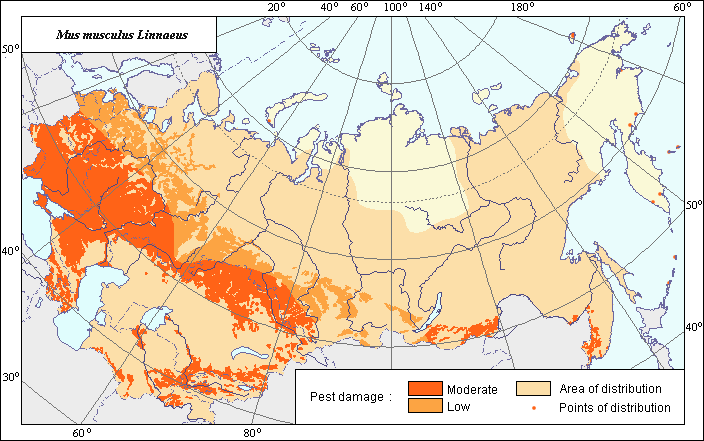Pests
Area of distribution and damage of House Mouse (Mus musculus Linnaeus)
 Object description Download GIS-layers
Object description Download GIS-layers
Authors:
Specialist-biologist F.A. Karlik,GIS-specialist M.I. Saulich.
Date of creation:
24.05.2004.Scale:
1:20 000 000.Accuracy of map:
Map was created based on materials of maps of natural scale 1:33 000 000, 1:47 000 000 and 1:90 000 000.Projection:
"Alber.s Equal Conica for the USSR", 9, 1001, 7, 100, 0, 44, 68, 0, 0.Basic content:
Vector map, which consists of 3 thematic layers, where area of distribution and zones of damage are shown by polygons.Accuracy of the classifier:
Within the area of distribution 2 zones of damage reflecting economic significance of this species in agricultural production were established. The zone of low damage is characterized by colonization of arable lands with catches of no more than 3 individuals per 100 traps/day. In the zone of moderate damage this index is usually 5-10 individuals per 100 traps/day, but it can reach 30 and more individuals per 100 traps/day in years of mass reproduction.Procedure of map drawing:
The area is based on the species distribution maps published by Bobrinskii et al. (1965) and Flint et al. (1970). Then the limits of the area in the territory of the Former Soviet Union were specified according to materials of detailed investigations taken from Prilutskaya (1989). Configuration of damage zones was accomplished based on the map of ecological zones of distribution of this species (Tupikova, 1947). Low damage manifests itself within the ecological zone, where the mice migration to fields happens only in warm season. The zone of moderate damage corresponds to the zone of year-round inhabiting of mice in agrocenoses and predominance of the House Mouse in a complex of small rodents during years of their mass reproduction. Original maps were scanned. Registration and vectoring of their raster copies was performed using standard means of GIS-technologies. Zones of damage were corrected according to the vector layer of arable lands (Koroleva, et al., 2003).Sources of the data:
Bobrinskii, N.A., Kuznetsov, B.A. & Kuzyakin, A.P. 1965. Keys to Mammals of the USSR. Moscow: Prosveshchenie. 382 p. (in Russian).Flint, V.E., Chugunov, Yu.D., & Smirin, V.M. 1970. Mammals of the USSR. Moscow: Mysl. 437 p. (in Russian).
Pavlinov, I.Ya., Kruskop, S.V., Varshavskii, A.A., & Borisenko, A.V. 2002. Land animals of Russia. Manual-Identification book. Moscow: KMK. 298 p. (in Russian).
Prilutskaya, L.I. 1989. The modern area of House Mouse in the USSR. In: Sokolov, V.E., ed. House Mouse. Moscow: IEMEZh AN SSSR. P.4-14 (in Russian).
Tupikova, N.V. 1947. Ecology of house mouse in the middle zone of the USSR. In: Formozov, A.N., ed. Fauna and ecology of rodents. Moscow: MOIP. P.5-65 (in Russian).

